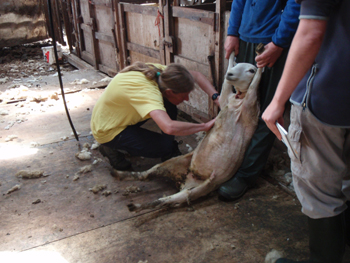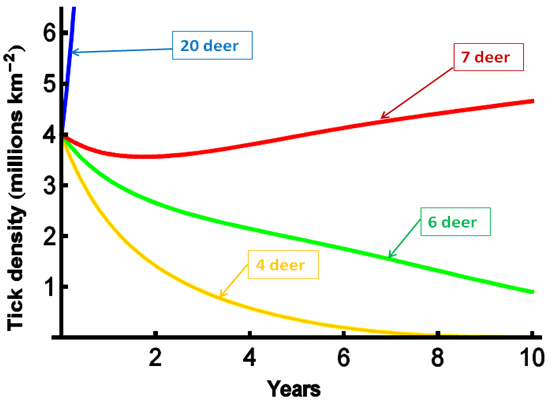Can acaricide treatment of sheep control ticks and tick-borne disease in the environment?
Published on 10 January 2011 in Sustainability and Communities , Food, health and wellbeing
Introduction
The tick Ixodes ricinus is the most important pathogen-carrying vector in Europe, including the UK. This species of tick is a generalist parasite, feeding off most types of terrestrial vertebrate, including sheep, deer, horses, dogs and humans. Because these ticks can feed off so many types of host, it is a particular challenge to control their numbers in order to reduce risk of disease. This also makes it a problem to empirically test the effectiveness of potential tick control methods, due to the difficulty in setting up controlled experiments in the natural environment. Therefore, in this project, we use mathematical models to predict how effective tick control methods might be at controlling ticks and disease. As a case study we use the example of louping ill virus. This tick-borne pathogen can kill livestock and red grouse, and the disease therefore has serious implications for rural economies and livelihoods, as well as animal health and welfare.
Key Points
Ticks and incidence of tick-borne diseases, such as Lyme borreliosis and louping ill, are currently increasing rapidly in the UK.
Research Undertaken
The mathematical model was built by Ros Porter in collaboration with Rachel Norman, both at Stirling University’s Department of Computing and Mathematics. The model, termed an “SIR” (Susceptible, Infected, Recovered) model, was a series of differential equations describing the rate of change of numbers of red grouse and ticks that are susceptible, infected and recovered from louping ill virus. Values for the model parameters were derived from empirical data (e.g. counts of ticks on sheep, deer and grouse – Fig. 1) and from the published scientific literature.

- How many treated sheep are needed for effective tick control?
- What efficacy of acaricide is required?
- What density of wild deer can there be before the methods becomes ineffective?

Porter, RB, Gilbert, L & Norman, RA. (2010) Controlling tick borne diseases through domestic animal management: a theoretical approach. Theoretical Ecology. (published online 20 May 2010, DOI: 10.1007/s12080-010-0080-2)
Policy Implications
These findings have clear implications for policy on sustainable tick control strategies, sheep acaricide treatment strategies, and deer population management. These are as follows:
- Benignly managing one host species to protect another species from a vector and pathogen can, theoretically, be effective, albeit under certain strict conditions.
- The importance of understanding the ecological complexity of a system, in order to target control methods under only specific circumstances for maximum effectiveness. In other words, it identifies conditions under which attempting this control method is unlikely to work.
- It also identifies the strict conditions that are needed for this treatment method to be effective, which can hopefully help land managers make informed decisions about whether or not the method is worth is trying.
Author
Dr. Lucy Gilbert (MLURI), Ros Porter and Rachel Norman (Stirling University) l.gilbert@macaulay.ac.uk
Topics
Sustainability and Communities , Food, health and wellbeing





